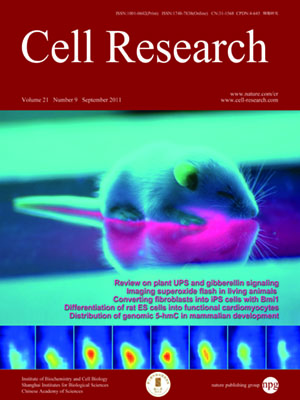
Volume 21, No 9, Sep 2011
ISSN: 1001-0602
EISSN: 1748-7838 2018
impact factor 17.848*
(Clarivate Analytics, 2019)
Volume 21 Issue 9, September 2011: 1343-1357
ORIGINAL ARTICLES
Indian hedgehog mutations causing brachydactyly type A1 impair Hedgehog signal transduction at multiple levels
Gang Ma1,2, Jiang Yu3, Yue Xiao1,2, Danny Chan4,5, Bo Gao1, Jianxin Hu1,4, Yongxing He3, Shengzhen Guo1,2, Jian Zhou1,2, Lingling Zhang1,2,
1Bio-X Center, Key Laboratory for the Genetics of Developmental and Neuropsychiatric Disorders (Ministry of Education), Shanghai Jiao Tong University, Shanghai 200030, China
2Institute for Nutritional Sciences, Shanghai Institutes for Biological Sciences (SIBS), Chinese Academy of Sciences, Shanghai 200031, China
3Hefei National Laboratory for Physical Sciences at Microscale and School of Life Sciences, University of Science and Technology of China, Hefei Anhui 230027, China
4Department of Biochemistry, the University of Hong Kong, Pokfulam, Hong Kong, China
5Centre for Reproduction, Development and Growth, LKS Faculty of Medicine, The University of Hong Kong, Pokfulam, Hong Kong, China
6Shanghai Institute of Mental Health, Shanghai 200030, China
7Life Science School, Ningxia University, Yinchuan 750021, China
8Institutes of Biomedical Sciences, Fudan University, Shanghai 200032, China
Correspondence: Lin He, Bo Gao,(helinhelin@gmail.com; indianhedgehog@hotmail.com)
Brachydactyly type A1 (BDA1), the first recorded Mendelian autosomal dominant disorder in humans, is characterized by a shortening or absence of the middle phalanges. Heterozygous missense mutations in the Indian Hedgehog (IHH) gene have been identified as a cause of BDA1; however, the biochemical consequences of these mutations are unclear. In this paper, we analyzed three BDA1 mutations (E95K, D100E, and E131K) in the N-terminal fragment of Indian Hedgehog (IhhN). Structural analysis showed that the E95K mutation changes a negatively charged area to a positively charged area in a calcium-binding groove, and that the D100E mutation changes the local tertiary structure. Furthermore, we showed that the E95K and D100E mutations led to a temperature-sensitive and calcium-dependent instability of IhhN, which might contribute to an enhanced intracellular degradation of the mutant proteins via the lysosome. Notably, all three mutations affected Hh binding to the receptor Patched1 (PTC1), reducing its capacity to induce cellular differentiation. We propose that these are common features of the mutations that cause BDA1, affecting the Hh tertiary structure, intracellular fate, binding to the receptor/partners, and binding to extracellular components. The combination of these features alters signaling capacity and range, but the impact is likely to be variable and mutation-dependent. The potential variation in the signaling range is characterized by an enhanced interaction with heparan sulfate for IHH with the E95K mutation, but not the E131K mutation. Taken together, our results suggest that these IHH mutations affect Hh signaling at multiple levels, causing abnormal bone development and abnormal digit formation.
Cell Research (2011) 21:1343-1357. doi:10.1038/cr.2011.76; published online 3 May 2011
FULL TEXT | PDF
Browse 2123


